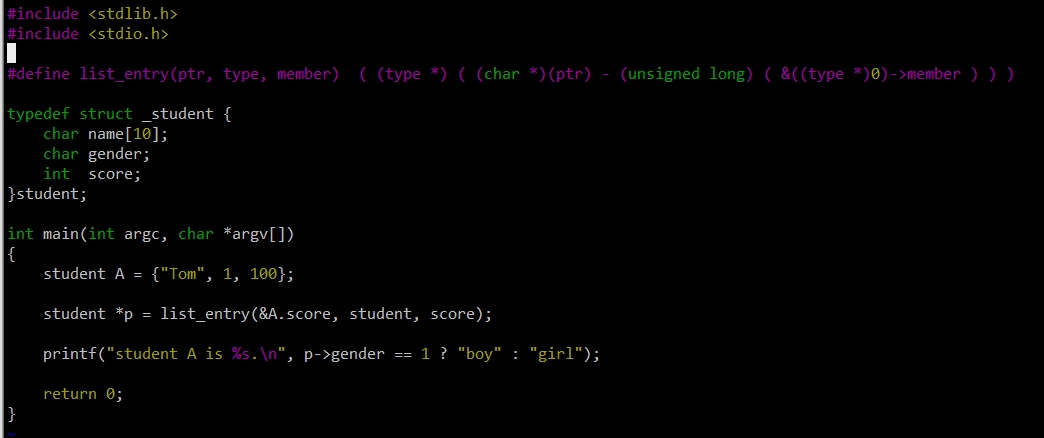1. /* round up for aligment */
#define round_up(x, aligment) ( ( ( (x) + ((aligment) - 1) ) / (aligment) ) * (aligment) )
round_up(7, 5) = 10
2. 取负数,再进行模运算 (-7 % 5 = 3 -> 7 加上 3 就可以被 5 整除)(整数A最少加上多少就可以被整数B整除)
void * memcpy (dstpp, srcpp, len) void *dstpp; const void *srcpp; size_t len; { unsigned long int dstp = (long int) dstpp; unsigned long int srcp = (long int) srcpp; /* Copy from the beginning to the end. */ /* If there not too few bytes to copy, use word copy. */ if (len >= OP_T_THRES) { /* Copy just a few bytes to make DSTP aligned. */ len -= (-dstp) % OPSIZ; BYTE_COPY_FWD (dstp, srcp, (-dstp) % OPSIZ); ... }
3. list_entry
#define list_entry(ptr, type, member) ( (type *) ( (char *)(ptr) - (unsigned long) ( &((type *)0)->member ) ) )
从一个结构体的成员指针找到其容器的指针
把0强制转化为指针类型,即0是一个地址,为段基址。以0为结构体的基址,再取结构体的成员member的地址,那么这个地址就等于成员member到结构体基地址的偏移字节数。
#define list_entry(ptr, type, member) container_of(ptr, type, member)
#define container_of(ptr, type, member) ({ const typeof( ((type *)0)->member ) *__mptr = (ptr); (type *)( (char *)__mptr - offsetof(type,member) );})
#define offsetof(TYPE, MEMBER) ((size_t) &((TYPE *)0)->MEMBER)

4. 获取一个数组的元素个数
#define SIZE_ARRAY(a) ( sizeof((a)) / sizeof((a[0])) )
5. 十六进制转换成整数
#define hexdigit(x) (((x) <= '9') ? 'x' - '0' : ((x) & 7 ) + 9 )
6. 大小写转换
c &= 0xDF; //小写字母转换成大写字母
c |= 0x20; //大写字母转换成小写字